MOBILIS IN MOBILI
By Andrew Maerkle
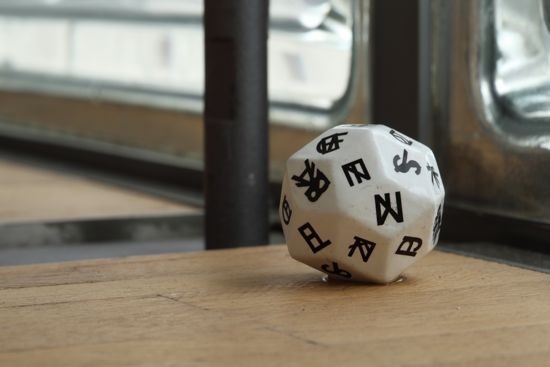 In Spades? (2011). A 30-sided die, made with a simple icon, character, marking made by the artist to represent each of the 30 previous shows in the exhibition space. Installation view at Le Forum, Maison Hermès, Tokyo. Photo © Keizo Kioku.
In Spades? (2011). A 30-sided die, made with a simple icon, character, marking made by the artist to represent each of the 30 previous shows in the exhibition space. Installation view at Le Forum, Maison Hermès, Tokyo. Photo © Keizo Kioku.Born in 1976, the English artist Ryan Gander explores the creative possibilities of alternate identities to produce works that challenge and upend the boundaries between fiction and reality, invention and convention. Like artifacts, such works are at once self-evident and opaque, exciting the human predilections of ascribing significance to the phenomena of the material world and questioning how things come into being or arrive at a condition of presentness. Tying together art historical sources, pop cultural and mass produced samplings ranging from the Dire Straits to IKEA, and personal references, each work stages a concentrated encounter with multiple imaginative threads.
Gander has exhibited widely in exhibitions including the Venice Biennale, the Carnegie International and the Biennale of Sydney. He has also had multiple exhibitions in Japan, including at Dazaifu Tenmangu Shrine Museum in Fukuoka and Taro Nasu Gallery in Tokyo. ART iT met with him before the opening of his recent solo exhibition at Tokyo’s Le Forum, Maison Hermès, “Icarus Falling – An exhibition lost,” to discuss his practice in greater detail.
I. Hiding in Plain Sight
II. Homo sum, humani a me nihil alienum puto
III. Timeo hominem unius libri
IV. Quod petis, hic est
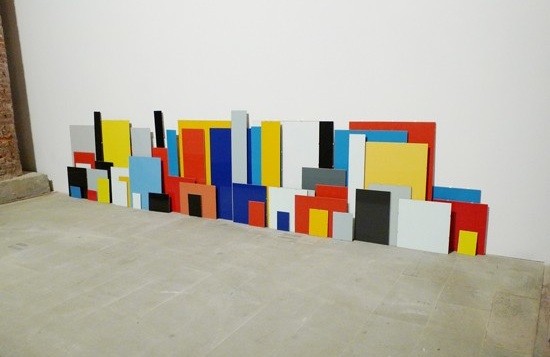 Your present time orientation (First Act) – Random abstraction (2011). The components of several Mondrian (and other various abstract Modernist composition painters) paintings separated into their solid colors and re-represented by painting a vast amount of differing shaped and sized cheap commercially available colored glass clip frames, exhibited casually leant against the wall as a random abstraction. Installation view at the 54th Venice Biennale, “ILLUMInations,” photo ART iT.
Your present time orientation (First Act) – Random abstraction (2011). The components of several Mondrian (and other various abstract Modernist composition painters) paintings separated into their solid colors and re-represented by painting a vast amount of differing shaped and sized cheap commercially available colored glass clip frames, exhibited casually leant against the wall as a random abstraction. Installation view at the 54th Venice Biennale, “ILLUMInations,” photo ART iT.ART iT: I am interested in how our relationship to knowledge has changed with the Internet, whereby not all, but quite a good deal of knowledge is now easily accessible. This accessibility in a sense puts knowledge in a state of obviousness, or hiding in plain sight. I see a parallel between this situation and the way that your works function, in that many of them redistribute different forms of knowledge in a way that is apparent but not always self-evident, and part of the relationship the viewer has with each work is choosing how deep to go into it. Is the mechanism of obviousness something that you conscientiously employ in your practice?
RG: It’s interesting you say this, because I’m not convinced people actually discover information on the Internet. The Internet doesn’t edit, so you can end up with a lot of stuff that is not interesting or relevant, and on top of that the idea of the hyperlink jumping from one subject to another is counteractive to research because it constantly moves you away from one subject to another subject. I have a feeling that people discover information through talking and communication, the instinctive human transmission of information. I feel people become interested in an idea because of a story – which they encounter sitting in a bar with a friend, for example – and then use the Internet to validate or expand that story, which is also ambiguous because everything on the Internet is not necessarily true.
In that sense the idea of “hiding in plain sight” is a good identification of my work. My works are similar to a conversation in a bar, introducing spectators to an idea or subject that has an interesting backstory, but then the spectators are always left to find out the rest for themselves. There’s no point in making an artwork that explains itself, because then it would just be illustration, not art.
ART iT: What about your use of referentiality, quotation and association in the collisions between fact and fiction that you orchestrate in your works?
RG: Being an artist, you have the privilege of not having to tell the truth. You can paint a carrot and say it’s an orange. That gives you the liberty to use your imagination, which is another privilege. It’s like when a child sits on a bed and pretends it’s a raft, floating through the sea, and the sock on the floor is a shark – usually we’re not able to do that as adults.
ART iT: Then, for example, do you have any responsibility to the knowledge that your works redistribute? What happens when you cite Van Doesburg and Mondrian and people who did exist, and when you appropriate elements of their work, as in Samson’s push, or No VI / Composition No. II (2011) and Your present time orientation (Second Act) – Random abstraction (2011), with the stacked Ikea tables and Plexiglas panels incorporating color schemes borrowed from geometrical abstraction?
RG: If you read a JG Ballard science-fiction story, would you consider it knowledge? No, because it’s fiction, and that’s the same thing with my work. I don’t think JG Ballard felt a sense of responsibility to knowledge when he wrote some of the most important books of the 20th century. I’m not making an illustration of history. I’m making art, so it doesn’t have to be true.
I think the difference with what I’m doing is that you have fact, factual knowledge, factual evidence, and factual practices like documentary photography or autobiography or illustration, and then you have fiction, which could be contemporary art or novels, and then you have what I’m trying to achieve, which is a para-possible merging of fact and fiction. In my works, you could get Mickey Mouse, who’s real, but not a person, meeting Mondrian, who’s real, but dead, meeting my father, all in the same room. You would have a collage of every realm of fact and fiction, and it would be the spectator’s liberty to decide what is real and what isn’t. The position from which I make my work is that everything is real, but just in my imagination.
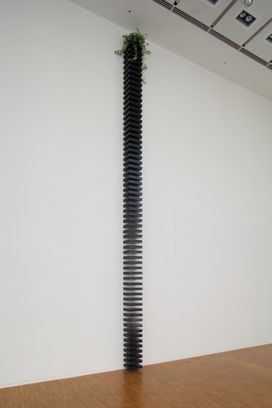
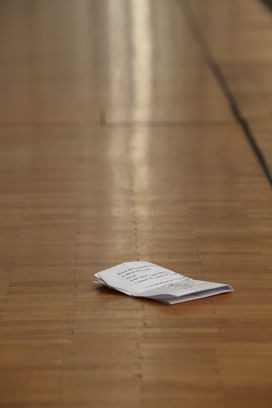
Left: I am broken (2011), customized IKEA Lack shelves, ivy plants. An artwork made to the same proportions as a small “stack” work by Donald Judd (1928-94), made entirely from the world’s most popular prefabricated LACK shelving system from the Swedish company IKEA, roughly cut to size with a hand saw. Right: The futility in drawing something that is moving (2011), ink on paper: An artwork in the form of a poem that describes another artwork, written by Marcel Broodthaers as imagined in 2019, age 96 years. Displayed as if discarded on the floor of the gallery. Both: Installation view at Le Forum, Maison Hermès, Tokyo. Photo © Keizo Kioku.
ART iT: So is there necessarily a critique embedded in turning Ikea furniture into a comment on Mondrian and Van Doesburg, or into a replica Donald Judd sculpture?
RG: It doesn’t matter if it’s a critique or not. It only matters whether the spectator thinks it’s a critique or not, because I’m not always sitting next to the work to answer that question. Sometimes it’s intended as a critique, sometimes as a comment, sometimes as a quote, but it’s always different depending on the work. There’s no specific political message or motivation. I’m purely playing with history as if I were a painter playing with colors.
Certainly I have opinions. I think it’s interesting that when Mondrian was painting he didn’t know Ikea would exist, and Ikea is a sort of endpoint to his research, and he probably would have been embarrassed that Modernism had reached everybody in that way – he probably wouldn’t have liked it. But these are just my speculations and not information that’s in the work.
ART iT: What keeps you coming back to history as a source?
RG: I don’t just come back to history. I come back to color, I come back to architecture, to design, to predicting the future, to the idea of currency, to the ideas of use, worth, function, authorship, ownership, cost – I come back to everything. It’s very easy to look at something as a subject, but the things that you might not classify as such, like devices or languages, are for me also subjects. I’ve made work about the size of an A4 piece of paper, where the format of the work was its content. The paper’s blank, so when you look at it you might think there is no content, and that it’s just a piece of paper. But actually what you’re looking at is a piece of A4 paper that’s 210 by 297 millimeters for a specific, historical reason. So really everything is content.
ART iT: But everything is system as well?
RG: The system is the content for me. That’s a better way of explaining it: everything is system, and the system is content. The design of the glass in front of me is a system, and there’s a currency attached to it because it’s an expensive Hermès glass; there’s an aesthetics attached to it because of the light green color that was chosen for it; there’s a design and ergonomics attached to it because it fits my hand perfectly and there are ridges for gripping and it’s smaller at the bottom and wider at the top so that it doesn’t fall through your hand and so that in a set they can be stacked into each other for easy storage. Everything is a system. When the traffic lights change outside, something will happen at the Imperial Palace because this car stopped and the next car stopped and the next car stopped, and because the last car stopped a mile away, it will mean that a lady will move forward, and she’ll see something that reminds her that she needs to call her mother, so she’ll call her mother. Everything is a system and everything is interconnected.
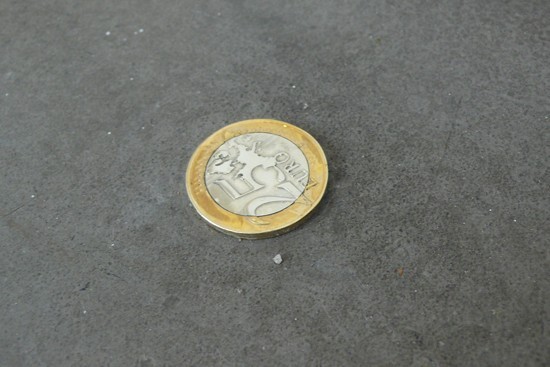 We never had a lot of € around here (2010), single metal coin, 25 mm Ø. A € 25 coin as envisaged as if it had fallen from 2036. The amount of which, in relation to denomination, is taken from a predicted average European area inflation rate. The design of the coin also incorporates an amended European map for the year and an amended number of union stars. The coin is value side up and is glued to the floor. Installation view at Annet Gelink Gallery, Amsterdam, 2011. Photo ART iT.
We never had a lot of € around here (2010), single metal coin, 25 mm Ø. A € 25 coin as envisaged as if it had fallen from 2036. The amount of which, in relation to denomination, is taken from a predicted average European area inflation rate. The design of the coin also incorporates an amended European map for the year and an amended number of union stars. The coin is value side up and is glued to the floor. Installation view at Annet Gelink Gallery, Amsterdam, 2011. Photo ART iT.ART iT: Then what happens when you isolate one aspect of the system as a subject?
RG: You can’t isolate it, you can only highlight it. The beauty of working in an art space is that whatever you put in it becomes charged. An art space amplifies the volume of what is “on display,” but really everything is still there, because all the systems are linked. In this meeting room that we’re in right now, the glass has no particular volume, but if you were to put the glass on the floor of the gallery, even though it’s still the same thing, it would then have a unique volume that would allow others to notice and think about it more deeply. So when I make a work, I’m not really separating something from the rest of the systems in the world, I’m just recontextualizing it so that it’s louder.
Return to Index
Ryan Gander: Mobilis in Mobili
